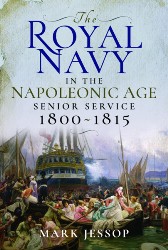 Pirates and Privateers Pirates and Privateers
The History of Maritime
Piracy
Cindy Vallar, Editor
& Reviewer
P.O. Box 425,
Keller, TX 76244-0425
    
Books for Adults ~ History: Navy
(United Kingdom)
The Royal Navy 1793-1800
The Royal Navy in
the Napoleonic Age

The Royal Navy 1793-1800:
Birth of a Superpower
by Mark Jessop
Pen & Sword, 2018, ISBN 978-1526720337, UK £19.99 /
US $34.95
    
The years
chosen for this study of the Royal Navy comprise a
period in which major changes affect almost all of
Europe and Britain grows to become the most powerful
navy in the world. This is an account of both world
events and the impact they have on the navy and
those at home and at sea. It opens in 1793, when
news arrives in England of the beheading of the
French monarch, Louis XVI. The first chapter sets
the stage, introducing readers to the lay of the
land and the readiness of the navy in the months
prior to France’s declaration of war. Over the next
eight years of fighting, the public bears a high
price to defeat Napoleon. Not only are income taxes
introduced for the first time, but freedoms are
lost, and families are torn apart.
What sets this book apart from other histories of
the Royal Navy is twofold. First, it contains
tidbits of information not found in other such
works. Second, and perhaps more importantly, it
connects ordinary people in their everyday lives to
a world at war and shows how this conflict alters
both them and the navy. Nor is this your typical
history; rather, it is a combination of fact and
fiction. Each chapter begins with a fictional
account steeped in historical facts from the
perspective of unnamed participants. For example,
chapter two recounts the tale of a Cornish miner who
takes the king’s shilling rather than face
unemployment. The miner is imagined, but he
represents one of eighty real miners who serve
aboard Sir Edward Pellew’s Nymphe when she
encounters the French Cléopâtre. The next
chapter, on the other hand, tells the story of a
press gang and the what-ifs and regrets a victim may
ponder.
A host of topics are covered within the chapters:
the cost of maintaining a navy and the number of
vessels in the beginning and at the end; who is
aboard the ships and what do they do; the Admiralty;
medical care; seamen’s pay, prize money, and the
1797 mutinies; and hazards at sea. Chapters six and
seven examine specific naval strategies and battles,
such as blockades, the Glorious First of June (the
first fleet action of the war), the Siege of St.
Jean d’Acre, amphibious operations, Barbary pirates,
and the Battles of Cape St. Vincent and Aboukir Bay.
The last chapter discusses the importance of gunnery
practice, naval stations in the Caribbean, and the
decline of British trade in the West Indies.
This book begins with a list of major events between
1793 and 1800. It ends with two bibliographies and
an extensive index. At the center of the book is a
section containing black-&-white artwork and a
series of maps. Footnotes, rather than endnotes,
make it easy for readers to check source citations,
read definitions, or discover other pertinent
information not contained in the main text.
The inclusion of the fictional scenes allows readers
to make a personal and more immediate connection
with the war and world at the end of the 18th
century. This is a highly readable history of the
Royal Navy that packs an abundance of information
into a scant 159 pages. Readers need not be familiar
with either the navy or nautical language to grasp
the content, and the book serves as a good
introduction to the Royal Navy at a critical time in
history.
Review
Copyright ©2019 Cindy Vallar


The Royal Navy in the Napoleonic
Age: Senior Service, 1800-1815
by Mark Jessop
Pen & Sword, 2019, ISBN 978-1-52672-038-2,
US $27.25 / UK £19.99
review by Irwin Bryan
    
This look at the
Royal Navy, known as the Senior
Service for being England’s first
permanently armed force, begins
towards the end of the French
Revolutionary War. It covers the
disarmament after the Peace of
Amiens, rearmament with the
resumption of hostilities, and the
entire Napoleonic War. That does
not mean the story is in
chronological order. Various
aspects of manning and building
the Royal Navy, as well as the
battles fought, are explored in
each chapter. Still, little
escapes the author’s attention,
much to our delight.
What
makes this history unique is the
way it is told. Instead of just
the traditional author narration
of events and facts, where Mr.
Jessop introduces us to actual
people – naval officers,
politicians, and Frenchmen – he
also intertwines anonymous
characters and ships into the
narrative. This is done to show
how individual men and women,
often nameless in history, are
swept up in the tide of war.
We
witness these events through
their eyes and thoughts as they
experience different scenarios.
This allows us to see what
happens from the different
perspectives of a Danish pilot,
a German émigré, a nurse, a poet
and his wife, a chaplain, an
invalided sailor, three friends
off the same ship who meet up
with three sisters of a fallen
comrade after Trafalgar, a
laborer, and an abolitionist,
among others.*
Without
realizing it, we acquire a host
of information in a far more
memorable way than had Jessop
presented the data in a more
traditional manner. Among the
topics he incorporates into this
book are building ships and
growing the Navy, tactics and
training, blockading, the moral
makeup of the fleet, warships
lost to fire and wrecking,
combat, fraud and embezzlement
by navy vendors and builders,
the growth and increase of
dockyard establishments, major
battles, and single ships trying
to capture each other, such as
the great frigate contests or
duels between smaller vessels,
like Frolic and Wasp.
How
the war affects the people of
the British Isles is also
explored. Everything from fear
of and preparation for a French
invasion, the impact of the
blockade to merchants and the
economy, Orders in Council, and
privateers preying on shipping,
to the attention folks pay to
the heroes of the day. Even
the slave trade is touched upon,
mostly through the story of
abolitionists’ outcries on its
evils. This ultimately leads to
the end of British participation
in slavery and the stationing of
their warships off the African
coast to end these deprivations
by other nations’ merchants.
The
War of 1812 is also covered. The
causes for America declaring
war, especially the impressment
of her sailors, are presented.
The stunning losses of British
frigates defeated by the
Americans leads to coverage of
the plight of French and
American sailors captured during
the fray. Yankees also face the
possibility of being forced to
fight for their enemy or being
considered a traitor and
punished. The horrors of the
prisons and prison hulks (former
ships of the line stripped of
their masts and boarded over on
top) demonstrate why few ever
left. Starvation, sickness,
daily deaths, paroled officers,
and prisoner exchanges are
discussed.
In
addition to the eminently
readable text and all it
contains, a chronology of major
events comes before the first
chapter. A detailed
bibliography, with a separate
listing of journals and
articles, is found before the
hundreds of notes that carefully
document where the book’s facts
are found. A section of plates
includes maps, battle diagrams,
and pictures of ships and people
mentioned in the book.
This
is truly one of the most
enjoyable history books I ever
remember reading! The way the
gems of wisdom contained in each
chapter are presented is
refreshing. If you want to learn
more about the naval side of the
Napoleonic Wars, Great Britain’s
Senior Service, or are just
looking for an informative read,
you will be hard-pressed to make
a better selection.
*Reviewer’s Note:
Although unnamed, the Reverend
William Hamilton Drummond is
the poet we meet with his
wife. The poetry lines we read
are from his 124-page "The
Battle of Trafalgar, A Heroic
Poem," which he published in
1806.
Review Copyright
©2022 Irwin Bryan


Click to contact me
Background image compliments
of Anke's Graphics |


